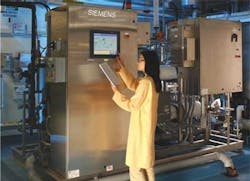New Feature Allows Measurement of Free Chlorine in a Handheld Instrument
By Richard James Spahl
The most popular germicide used in water treatment is chlorine, which kills bacteria by way of its power as an oxidizing agent. Chlorine is used not only as a primary disinfectant at the beginning of the treatment process, but also at the end to establish a residual level of disinfection during distribution as a guard against future contamination.
The most popular field test instruments and test systems for judging the level of residual chlorine, also called Free Available Chlorine (FAC), are based on colorimetric methods whereby dyeing agents are added to the sample being tested. These additives react to FAC causing a color change in the test sample. While they may detect the presence of FAC, they do not directly measure the electrochemical characteristic of FAC responsible for its disinfecting power: Oxidation-Reduction Potential (ORP).
The Myron L Company Free Chlorine Equivalent (FCE) feature, available on its handheld Ultrameter series, avoids these pitfalls by directly measuring ORP, the germ-killing property of chlorine and other oxidizing germicides. It displays both the ORP reading (in millivolts DC) for the sample being tested as well as an equivalent free chlorine concentration in familiar ppm (parts per million). The measurement function also accounts for the very significant effect of changing pH on chlorine sanitizing power and can be used to track other types of oxidizing germicides.
FCE employs a predictive ORP-based measurement derived mathematically through a proprietary algorithm that extrapolates a final, stable ORP value of a solution without waiting out the long response time of the typical ORP sensor.
This sometimes lengthy response time is one of the challenges in implementing an ORP-based free chlorine measurement in a handheld field instrument. The FCE function is pioneering in how it reduces the wait for stable ORP readings. This feature determines an ORP reading within 1 to 2 minutes rather than the typical 15 minutes or hours for other ORP systems.
The Predictive ORP feature's calculations are based on a model of sensor behavior developed through a series of experiments that measured the response time of a representative sample of ORP sensors over a range of controlled chlorine concentrations. The results of this set of experiments revealed that the shape of the curve is very similar for various ORP levels differing only in the initial starting point and the final stabilized reading.
Using a proprietary curve-matching algorithm based on this data, the Predictive ORP feature determines what point along the typical sensor response curve a measurement occurred and extrapolates an appropriate final reading. This extrapolated value is returned as the FCE ppm value without having to wait for the sensor to stabilize and is also reported directly to the instrument's display for hastened ORP reporting.
This predictive ORP reading is transparent throughout the free chlorine measurement. When the FCE function is active, the instrument display alternates between the Predictive ORP reading (mV) and the Free Chlorine Equivalent concentration (ppm).
However, ORP cannot be converted to free chlorine concentrations, even when the chemicals in solution are known, without consideration of the pH value of the solution at the time of measurement. While other handheld instruments may measure only ORP, FCE instruments correlate ORP and pH with FAC concentration. The feature cross-references ORP values with pH levels to automatically arrive at a concentration value for FAC that reflects the effect of pH on the ratio of HOCl to OCl-. This correlation is derived from a series of experiments in which exact amounts of chlorine (in the form of laboratory grade bleach: 5% NaOCl; 95% H2O) were added to deionized water in a closed system, thus controlling and excluding possible interferants. By using both a pH measurement and an ORP measurement, FCE can determine the relative contributions of HOCl and OCl- to the final ORP value and factors them into a final concentration calculation.
Similar experiments were performed using water to which precise amounts of calcium chloride (CaCl2) and sodium bicarbonate (NaHCO3) were added to slightly buffer the water. This allows the FCE feature to correlate low ORP values to the typically low FAC concentrations of tap water after it has been in the municipal water system for several days.
The ability to include pH in the concentration calculation allows the FCE to compensate for the effect of the changing ratio of chlorine species as pH changes, resulting in a FAC concentration value germane to the actual sanitizing power of the source water. OCl- is measured as OCl-, and HOCl is measured as HOCl.
In addition, because the function displays both the FAC concentration and a predictive, stable ORP value, the user can, by comparing these two values from successive measurements, track how ORP (and disinfecting power) falls as pH rises and how ORP rises as pH is lowered when concentration is constant.
Another advantage of an ORP-based measurement is that, within the limits of its range, it can be used to measure the disinfection effectivity of any oxidizing germicide. The FCE measurement can be used with non-bleach oxidants, such as chloramines or even non-chlorine oxidants, such as peracetic acid, bromine or iodine.
While the concentration values reported by the function will not be absolutely correct for non-FAC oxidants, since they are based on a HOCl / OCl- model, FCE can still be an effective tool for monitoring relative changes in concentration levels. For absolute accuracy a correlative study should be performed to relate concentration levels of the oxidant in question to the ORP values displayed by the Predictive ORP feature and ppm values output by the FCE.
About the Author: Richard James Spahl is Quality Engineering Manager at Myron L Co.
"Myron L® is an exhibitor at the ACE® '12 event and can be found at Booth No. 1936"
More WaterWorld Current Issue Articles
More WaterWorld Archives Issue Articles


